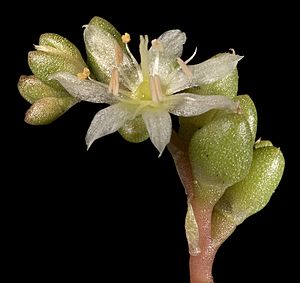Calandrinia granulifera facts for kids
Quick facts for kids Calandrinia granulifera |
|
|---|---|
 |
|
| Scientific classification | |
| Genus: |
Calandrinia
|
| Species: |
granulifera
|
| Synonyms | |
|
Claytonia granulifera (Benth.) F.Muell. |
|
Calandrinia granulifera is a small plant that grows for only one year (it's an annual herb). It belongs to the Montiaceae plant family. You can find this plant growing naturally in many parts of Australia, including New South Wales, Tasmania, Western Australia, South Australia, and Victoria.
About Calandrinia granulifera
This plant is a succulent, meaning it has thick, fleshy parts that store water. It can grow upright or spread out along the ground. Its flowers are white to pink and bloom from September to November.
You'll often find Calandrinia granulifera growing in sandy or gravelly soil. It likes places like granite rocks and hillsides.
Plant Parts and Flowers
The small flowers grow on tiny stems called pedicels, which are about 0.5 to 2 millimeters long. These stems stand straight up when the plant is forming fruit.
The plant has special leaves called bracts, which are arranged alternately along the stem. The sepals, which are like small leaves protecting the flower bud, fall off as the flower grows. They are about 1.5 to 3 millimeters long. Each flower has 5 to 7 petals, 5 to 10 stamens (the parts that make pollen), and 3 stigmas (the parts that receive pollen).
Seeds and Capsules
After flowering, the plant produces a black capsule that holds its seeds. This capsule is almost round and has three short sections called valves. These valves open only at the very top to release the seeds.
Inside, there are many tiny, shiny seeds that are reddish-brown. Each seed is about 0.5 millimeters long and 0.4 millimeters wide. If you want to see a picture of these bumpy seeds, you can look them up on the PlantNet website.
How it was Named
The plant Calandrinia granulifera was first officially described by a scientist named George Bentham in the year 1863. This means he was the first to give it its scientific name and publish details about it.

